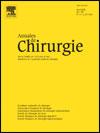Les kystes hydatiques du foie rompus dans les voies biliaires. À propos de 64 cas - 01/01/01
Riassunto |
But de l'étude : Cette étude rétrospective avait pour but de rapporter une série de kystes hydatiques (KH) rompus dans les voies biliaires observés au Maroc et opérés dans le même centre.
Patients et méthodes : De 1991 à 1998, sur 250 KH du foie opérés, 64 étaient compliqués de rupture dans les voies biliaires, soit 25 %. Il y avait 39 hommes et 25 femmes. L'âge moyen était de 34,2 ans (extrêmes : 8-60 ans). Les signes révélateurs ont été des douleurs du flanc droit, un ictère ou une poussée d'angiocholite mais la fistule biliokystique était latente dans plus de 50 % des cas. L'échographie a permis de reconnaître le ou les kystes hydatiques dans tous les cas mais a seulement permis de soupçonner la fistule biliaire dans 17 cas. L'intervention a consisté, après vidange et stérilisation du kyste, en une résection du dôme saillant (RDS) (n = 53) (84,4 %), une désobstruction de la voie biliaire principale (VBP) (n = 21) suivie d'un drainage par un drain de Kehr et le traitement de la fistule biliokystique a consisté en une suture (n = 23) ou un drainage bipolaire (n = 24) ou une déconnexion kystobiliaire (n = 15).
Résultats : Il y a eu deux décès postopératoires par choc septique (n = 1) et par encéphalopathie secondaire à une cirrhose biliaire (n = 1). Le taux de morbidité a été de 25 %. Parmi les complications, il y a eu quatre abcès sous phréniques, quatre fistules biliaires prolongées et deux occlusions intestinales. La durée moyenne de séjour hospitalier a été de 20 jours.
Conclusion : L'ouverture des KH du foie dans les voies biliaires peut être latente ou révélée par une symptomatologie biliaire. Les résultats obtenus dans cette série, comparés aux données de la littérature suggèrent que les méthodes conservatrices, surtout la déconnexion kystobiliaire après résection du dôme saillant sont simples et donnent de bons résultats à court et long terme malgré une importante morbidité et une hospitalisation prolongée.
Mots clés : foie ; kyste hydatique ; voie biliaire.
Abstract |
Study aim: The aim of this retrospective study was to report a series of patients with hydatid cyst opened in the biliary tract, who were operated in Morocco.
Patients and method: From 1991 to 1998, among 250 hydatid cysts of the liver operated in the same center, 64 were in communication with the biliary tract (25%). There were 39 men and 25 women. The mean age was 34.2 years (range: 6-60). The revealing symptoms were abdominal pain, jaundice or cholangitis, but the biliary fistula was asymptomatic in more than 50% of the patients. The hydatid cysts were recognized by ultrasonography in all the patients but the biliary fistula was only suspected in 17 patients. The surgical procedure included drainage and sterilization of the cyst, resection of the protruding wall of the cyst (84.4%), unblockage of the main hepatic duct (n = 21) associated with a Kehr drainage, and treatment of the bilio-cystic fistula with suture (n = 23) or double side drainage (n = 24) or cystobiliary disconnection (n = 15).
Results: There were two postoperative deaths due to septic shock (n = 1) and encephalopathy secondary to a biliary cirrhosis (n = 1). The morbidity rate was 25%. Among complications, there were four subphrenic abscesses, four prolonged biliary leakages and two intestinal obstructions. The main hospital stay was 20 days.
Conclusion: The opening of hyatid cysts of the liver into the biliary tract may be silent or revealed by biliary symptoms. The results of this series favour a conservative procedure, including resection of the protruding wall of the cyst and cysto-biliary disconnection, in spite of a high morbidity rate and a long hospital stay.
Mots clés : liver ; hydratid cyst ; biliary duct.
Mappa
Vol 126 - N° 3
P. 242-245 - Aprile 2001 Ritorno al numeroBenvenuto su EM|consulte, il riferimento dei professionisti della salute.

